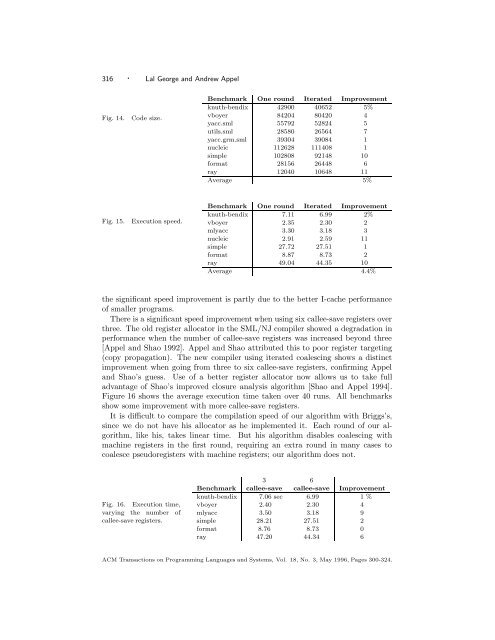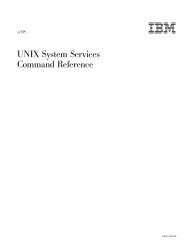Iterated Register Coalescing - School of Computer Science
Iterated Register Coalescing - School of Computer Science
Iterated Register Coalescing - School of Computer Science
Create successful ePaper yourself
Turn your PDF publications into a flip-book with our unique Google optimized e-Paper software.
316 · Lal George and Andrew AppelFig. 14.Code size.Benchmark One round <strong>Iterated</strong> Improvementknuth-bendix 42900 40652 5%vboyer 84204 80420 4yacc.sml 55792 52824 5utils.sml 28580 26564 7yacc.grm.sml 39304 39084 1nucleic 112628 111408 1simple 102808 92148 10format 28156 26448 6ray 12040 10648 11Average 5%Fig. 15.Execution speed.Benchmark One round <strong>Iterated</strong> Improvementknuth-bendix 7.11 6.99 2%vboyer 2.35 2.30 2mlyacc 3.30 3.18 3nucleic 2.91 2.59 11simple 27.72 27.51 1format 8.87 8.73 2ray 49.04 44.35 10Average 4.4%the significant speed improvement is partly due to the better I-cache performance<strong>of</strong> smaller programs.There is a significant speed improvement when using six callee-save registers overthree. The old register allocator in the SML/NJ compiler showed a degradation inperformance when the number <strong>of</strong> callee-save registers was increased beyond three[Appel and Shao 1992]. Appel and Shao attributed this to poor register targeting(copy propagation). The new compiler using iterated coalescing shows a distinctimprovement when going from three to six callee-save registers, confirming Appeland Shao’s guess. Use <strong>of</strong> a better register allocator now allows us to take fulladvantage <strong>of</strong> Shao’s improved closure analysis algorithm [Shao and Appel 1994].Figure 16 shows the average execution time taken over 40 runs. All benchmarksshow some improvement with more callee-save registers.It is difficult to compare the compilation speed <strong>of</strong> our algorithm with Briggs’s,since we do not have his allocator as he implemented it. Each round <strong>of</strong> our algorithm,like his, takes linear time. But his algorithm disables coalescing withmachine registers in the first round, requiring an extra round in many cases tocoalesce pseudoregisters with machine registers; our algorithm does not.Fig. 16. Execution time,varying the number <strong>of</strong>callee-save registers.3 6Benchmark callee-save callee-save Improvementknuth-bendix 7.06 sec 6.99 1%vboyer 2.40 2.30 4mlyacc 3.50 3.18 9simple 28.21 27.51 2format 8.76 8.73 0ray 47.20 44.34 6ACM Transactions on Programming Languages and Systems, Vol. 18, No. 3, May 1996, Pages 300-324.









